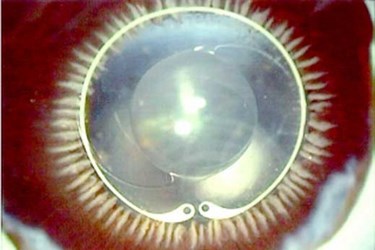An Implantable Eye Sensor To Monitor For Glaucoma
By Joel Lindsey

Researchers at the University of Washington have created a new device that could be implanted into a person’s eye to track changes in pressure typically associated with the onset of glaucoma. The device could lead to more immediate diagnoses and more effective treatment of the disorder.
“No one has ever put electronics inside the lens of the eye, so this is a little more radical,” Karl Böhringer, a professor of electrical engineering and bioengineering at UW who is involved with the project, said in a press release published recently by the university. “We have shown this is possible in principle. If you can fit this sensor device into an intraocular lens implant during cataract surgery, it won’t require any further surgery for patients.”
Researchers say that designing the device to be embedded into a patient’s eye during cataract surgery makes sense, given that cataracts and glaucoma both tend to affect a similar age demographic.
Using a tiny circular antenna that runs along the perimeter of the lens implant, the prototype device gathered enough energy from the surrounding field to operate its specialized low-power pressure sensor. When changes in pressure were detected, the device transmitted the data via radio frequency waves to a nearby receiver, where it was processed, analyzed, and recorded.
The data generated by the device could be communicated to a handheld device like a smartphone, as well as to a person’s eye doctor, providing real-time feedback and a chance for early diagnoses of glaucoma.
“Oftentimes damage to vision is noticed late in the game, and we can’t treat patients effectively by the time they are diagnosed with glaucoma,” said Tueng Shen, a professor of ophthalmology at UW and collaborator on the project. “Or, if medications are given, there’s no consistent way to check their effectiveness.”
Details regarding the new device, as well as results from tests run on the prototype model, were published recently in the Journal of Micromechanics and Microengineering.
According to UW’s press release, the prototype device was successfully tested on the same flexible silicon material used to create artificial implant lenses, but was too large for use as an actual implant. Researchers are now focusing on finding ways to downscale the device and hope to move it into another round of tests in the future.
“I think if the cost is reasonable and if the new device offers information that’s not measureable by current technology, patients and surgeons would be really eager to adopt it,” said Shen.
Image credit: Abbot Medical Optics and Optech
